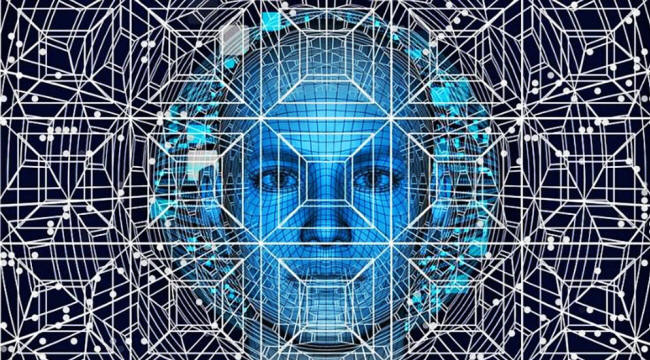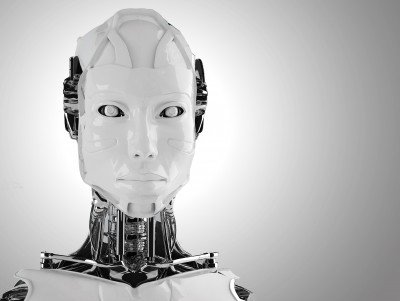
by Patrick Tucker
April 01, 2014
from DefenseOne Website
Joint Chiefs Chairman Gen. Martin Dempsey
controlling a prosthetic arm during a visit to
DARPA Defense Department
DARPA’s Arati Prabhakar
tells Defense One that
cutting-edge biology research
is the future of national security,
and how we’ll get our
Star Trek tricorders…
The ability to link human brains to machines, create new life forms and build Star Trek-style disease detectors will be the focus of a new Defense Department office soon.
The new office, named the Biological Technology Office, or BTO, will serve as a clearinghouse for Defense Advanced Research Projects Agency, or DARPA, programs into brain research, synthetic biology and epidemiology.
The office will cover everything from brewing up tomorrow’s bioweapon detectors and connecting humans to computers to designing entirely new types of super-strong living materials that could form the basis of future devices.
Here are the key areas in more detail.
Cyborgs, Neurochips and Brain-steered Drones
The human brain is often called the most complex object in the known universe, composed of 100 billion neurons and 100 trillion synapse connections.
As a computer, it performs 10,000 trillion operations per second. That’s about one third as fast as the Chinese Tianhe-2 Super computer, which can perform 33,860 trillion calculations per second.
But the human brain does it’s calculating with just 20 watts of power. Tianhe-2 needs 24 million watts.
In the last two decades, our understanding of the human brain has advanced tremendously through functional magnetic resonance imaging, or fMRI, magnetoenceplograhy, and high-resolution brain scans.
Our ability to use brain signaling to control devices has grown at a similar pace, but getting brain material to mesh with sensors and electronics is no simple matter.
A DARPA program, Revolutionizing Prosthetics, to better help veterans with amputated limbs control prosthetic legs and arms with brain signals was announced in 2009 but only very recently began to bear fruit.
Last year, researchers from the Rehabilitation Institute of Chicago demonstrated a cybernetic arm prosthetic that functions like something straight out of RoboCop.
The BTO will oversee a variety of programs aimed at understanding both the hardware and the software of the human brain.
“The prosthetics that are wirelessly neurally-controlled are just at the research stage.
But some of the ones where the prosthetics are connecting in to the peripheral nervous system or are being controlled by other muscles in the body are currently in an FDA process,” said Arati Prabhakar, DARPA director, in an interview with Defense One.
So while we still haven’t been able to connect a prosthetic directly to the brain, researchers have achieved much better integration with prosthetics and nerves.
Prabhakar says that the research has applications well beyond helping veterans to live better lives, including the creation of devices and chips that mimic the brain.
“That kind of amazing capability is something that no one thought was possible.
What we’re learning about the human brain could give us insight into how we build our artificial processing capabilities.”
The agency’s Cortical Processor program, with a $2.3 million FY 2015 budget request, seeks to recreate in software the brain’s capability to take in lots of incoming stimuli from sensory organs and spit out recognized patterns.
“There is a processing structure in nature, the mammalian neocortex, that… routinely solves the most difficult recognition problems in real-time…” according to the agency’s
recently submittedbudget proposal.
One far off potential application for the agency’s brain research is neural-controlled piloting of drones or better steering for manned aircraft via neurological feedback, which could build off of current research using electroencephalography, or EEG, to pilot robots.
EEG is a nonsurgical method for recording the brain’s electromagnetic signals via a cap that’s worn over the skull. Those signals are powerful enough to steer some robots.
In 2010, Northeastern University Electrical engineering professor Deniz Erdogmus and several researchers successfully demonstrated the piloting of a Roomba robot vacuum cleaner using thoughts.
In 2012, Chinese researchers at Zhejiang University used EEG to pilot a small consumer UAV.
These are the sorts of incremental research breakthroughs that seem to suggest that brain-controlled quad-copters are literally hovering around the corner.
But EEG signals are too crude to do brain-based piloting in real time combat operations. Useful gains in this area will require getting not just powerful but more precise signals, and that means getting hot electronics closer to the brain.
Unfortunately, soft and delicate brain tissue does not easily mix with circuits. It’s a technical and materials challenge of enormous complexity, but hardly outside of the realm of possibility.
A group of researchers from Singapore recently unveiled a neural probe that can be integrated on the brain with little damage to cellular structures.
Prabhakar is cautiously optimistic about the future of human-computer interfacing.
She says that current research represents “a door opening” into new applications.
“I would say we are now standing on this side of the door looking through and seeing what’s going to come out of it.”
In the near term, a fuller understanding of our three-pound thinking organ would allow for improved situational awareness on the battlefield and better decision-making in life or death environments.
“Think about warfighters in these very complex situations where the way that they understand the complexity around them makes all the difference in the world…
We’re speculating but it might lead to some great advances.”
Turning the Building Blocks of Life into New Materials
You can define synthetic biology, loosely, as the creation of new, artificial biological structures for new purposes. The field is in its infancy and DARPA’s new office is meant to accelerate current research.
One example of that is the 1,000 Molecules program, part of DARPA’s Living Foundries initiative, which is focused on,
“creating a biologically based manufacturing platform to provide rapid, scalable access to new materials with novel properties.”
These new materials would allow for a,
“new generation of mechanical, electrical, and optical products.”
“What our program is trying to do is create the tools to make [synthetic biology] an engineering discipline. Instead of taking millions of dollars and many years to do even minor projects, we really want to unleash it,” said Prabhakar.
“Think about what’s going to be possible for new chemistries beyond petrochemicals.
Think about new types of chemicals with all kinds of structural and electronic and optical properties.”
Bioengineered materials derived from living components like lipids and proteins would be several times more diverse and functional than designs based on more traditional approaches to chemistry.
Learning to harness the building blocks of life could allow for living materials that are stronger, more flexible, more durable and cheaper than anything available today.
Those new materials could make their way into battlefield armor or even electronic components.
Synthetic biology also holds the promise of one day creating entirely new life forms.
A group of researchers from the U.S. and U.K. recently announced the creation of the first artificial chromosome, derived from piecing together 273,871 separate DNA nucleotides from yeast, thus achieving a key step in the potential development of designer chromosomes or even new life…!
Tricorders, Epidemics and Outrunning Disease
On Star Trek, the USS Enterprise’s doctor, Bones, carries around a handheld device called a “tricorder” that can instantly diagnose any disease.
DARPA wants it…
Rapidly spreading diseases, whether as a result of biological attack or a naturally-occurring epidemic, present a grave and rising national security threat.
As previously discussed, a highly-lethal flu pandemic (news from April 2014…!) could result in as many as 150 million deaths.
DARPA is looking to create new diagnostic gadgets and software to give soldiers and decision-makers,
“a rapid and specific diagnosis of infection so we can actually understand the spread of disease, something we don’t have visibility into right now.”
The ability to diagnose infections on site, perhaps with a single, handheld device, and then report the results immediately and globally could allow researchers to quickly identify the unique genetic makeup of emerging illnesses.
That could help them to,
“create vaccines that offer immediate protection rather than vaccines that have a few week waiting period before immunity establishes itself.
If we can get those capabilities built, we can move faster than the disease is spreading,” said Prabhakar.
The DARPA program is called Autonomous Diagnostics to Enable Prevention and Therapeutics, or ADEPT, and is one example of the effort to conquer biological threats.
The agency isn’t alone in moving to build more rapid and deployable diagnostic capabilities.
Qualcomm and the X Prize Foundation are sponsoring a $10 million dollar competition to build a handheld diagnostic device. We don’t have to wait for Bones to show before realizing the benefits of the research effort.
Today, health workers in Saudi Arabia are already using findings from DARPA’s epidemiology-funded research to stay ahead of the Middle East respiratory syndrome coronavirus or MERS-CoV.
Prabhakar said it’s a fine and difficult line to walk, laying the research groundwork for the far future while offering new tools as quickly and as rapidly as possible.
“We always are aiming for off-scale impact,” she said.
“Meantime, we want to make sure we are delivering concrete capabilities.”
by Jake Anderson
August 30, 2019
from TheMindUnleashed Website

Eventually, the cyborgs
will modify the Earth
to suit to their needs,
which might lead to
the extinction of humans…
Elon Musk recently stated his belief that most humans are already cyborgs.
Noting our physical dependence on smart devices, the near ubiquitous presence of machines in our lives, and our obsession with online networks, Musk says the only thing stopping us from being being full-blown cyborgs (the kind imagined in movies) is input/output limitations.
But that day is on the horizon, and independent scientist James Lovelock argues that it could come sooner than we think.
The British futurist Lovelock is the author of a new book Novacene, which argues that we are in the early phases of what will be a total artificial intelligence takeover of the Earth.
The new dominant species will be a self-sufficient robot/artificial intelligence hybridization that aims to modify the Earth.
“Our supremacy as the prime understanders of the cosmos is rapidly coming to an end,” Lovelock argues in his book.
“The understanders of the future will not be humans but what I choose to call ‘cyborgs’ that will have designed and built themselves.”
Lovelock says it is difficult, if not impossible, for us to know what the cyborgs will look like because exponential technological growth over the next several decades and centuries will so dramatically alter computer systems and processing platforms.
Lovelock imagines future cyborgs could be spherical objects, or, he says,
“it’s entirely possible they would have no form at all” and will exist as virtual beings on vast digital substrates.
Lovelock’s theory is an offshoot of the Gaia hypothesis he developed in 1974.
The Gaia hypothesis posits that the Earth is a single, self-regulating system that pushes and evolves to facilitate more complex forms of life and intelligence.
Future cyborgs, it follows, will evolve from today’s rudimentary systems and will recognize the need for more sustainable ecosystems. This doesn’t necessarily mean they will kill humans off, as imagined by the Terminator movies, but they will likely seek to modify the Earth.
At first this could involve geo-engineering to control climate change, but eventually the cyborgs’ needs may become different than our own.
They may terraform the Earth to make it more silicon-friendly and, in the process, make it less hospitable for carbon-based life forms.
“Eventually, organic Gaia will probably die,” Lovelock speculates.
“But just as we do not mourn the passing of our ancestor species, neither, I imagine, will the cyborgs be grief-stricken by the passing of humans.”
Lovelock is certainly not the only thinker to imagine a future world run by advanced artificial intelligence entities.
Ray Kurzweil, author of The Singularity Is Near, and dozens of other futurists speculate that exponential technological growth will make intelligences of the future incomprehensible to our current minds.
The big question is,
whether traditional biological humans will be around to deliver their mail…












